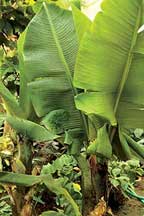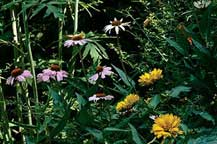Why I’ll never go native

I ran a lovely article on native wildflowers, complete with gorgeous photographs (see above) in the April issue of the magazine, but I find them an inadequate solution for most urban gardens—particularly for a formally designed courtyard garden on a street of Italianate Victorian houses.
And here’s the thing: our gardens—for the most part—are not natural or "native." They aren’t swamps, meadows, or woodlands. (Read Christopher Lloyd's description of his tortuously-maintained "meadow.") They are highly artificial constructs where plants that would never be seen growing near each other are forced into close proximity, and then pruned, divided, and cultivated into submission. So to say that using flowers native to your area is somehow better than using any other flower doesn’t make much sense to me. Our models for gardening come largely from the 18th and 19th century British master designers—and none knew better how to bend a landscape to their will. Indeed, it must be from them that we’ve gotten our obsession with emerald green lawns (not that I share that obsession).
So in my garden you’re much more likely to see this

than this

The tropicals speak to the Victorian obsession with the exotic—appropriate, I suppose, for the days when the sun never set on the British empire.
(This was supposed to be posted from Italy, but I didn't get to it.)

Comments
A lot of my garden is flagstones. If I had an all-dirt space, no doubt I'd be singing a very different tune.
Mixing it up is always the best way, I agree.
I find most people interested in “native” plants here are more interested in low water using plants (Xeriscape plantings), and just use the term “native” to describe this type of planting. If they can incorporate other low water using plants from The Mediterranean region, Australia, South Africa, etc. they can create a beautiful gardens while still using less or no water. I will remind folks that from about June to September we receive almost no rain here. For a plant to survive it has to be a plant from other “no summer water” areas.
Here, if you use only natives to your region, your choices will be limited. Expand your choices to include all xeriscape plants from other Mediterranean climate regions, and you can put together a great garden.
I like to mix non-natives into my garden as much as anyone, but I do see the value in all-native gardens, like the ones at the Wildflower Center in Austin. One doesn't have to go completely native to benefit from using at least some. If we can bring local flavor into our gardens, we'll fit in better with the natural world, and towns across the U.S. won't look exactly the same but will have a regional identity.
I try to be environmentally sensitive by not planting and replacing invasive non-natives. It seems that every plant that grows here without much trouble has been labelled an invasive by the city and we're warned that when they escape into the wild they harm native plants and wildlife. Yikes!
As for non-natives, I could hardly have a vegetable garden without them.
interesting read, what I will say is that wheteh they are native to Lansdale or not, the anise hyssop in my backyrad had 5 male goldfinches very happy yesterday. well they were happy until I went out to harvest a hot pepper, new zealand spinach, a red onion, and some basil; at which point they flew off for a while.
Don't get me wrong, I think that your style of garden is beautiful in its own right, but I can't help but get pleasure from the fact that the homeowner's association bitches every spring about my yard being an eyesore and lowering property values, and come summer, I have one of the greenest yards and the lowest water bill. Then the H.O.A. apologizes, winter rolls around, and we rinse and repeat.
So I guess I could call this "Why I'll never go exotic." We come from completely different schools of gardening, but we seem to meet in the middle at one point: we want to be able to look at our property and see beautiful plants.